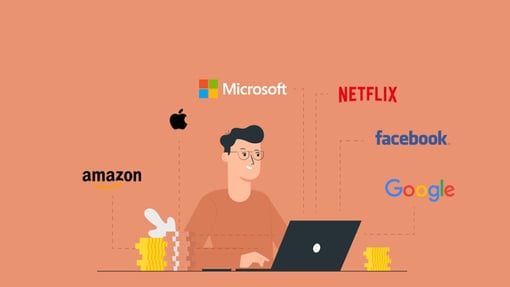Is Your Portfolio Diversified Enough for an Increasingly Global World?
5 minutes read

As you have probably noticed, and may have heard a gazillion times before, we are living in an increasingly global world, where borders are becoming virtual and one can access goods and services offered across the globe with greater ease. Whether it is the latest smart-phone, a Netflix special, or a ride-sharing app, Indian consumers have been enjoying the same level of access as the developed world (well, mostly). As an Indian consumer, we are constantly exposed to global brands like Amazon, Netflix, Apple, Uber, P&G, and the likes.
Indian travelers are also becoming global. We are exploring new destinations overseas, are participating in luxury and adventure travel with equal zest, and spending more in travel every year. Our overseas education bills have been going up too, as more and more students make their way into international schools and universities.
However, when it comes to investing and saving, we, as Indian residents, are often restricted to domestic choices. Part of this was by design, due to strict capital control laws that restricted remittance and conversion of the Indian Rupee to foreign currency. However, RBI has liberated this channel, and under the Liberalized Remittance Scheme (LRS), Indian individuals can remit and invest up to USD 250,000 overseas per financial year. This is a large enough limit if you consider that a family of four can invest and spend up to $1 million overseas every year. A more challenging factor for poor international investment choices is the lack of a convenient and accessible platform to be able to do so. Although a few brokerage houses and portfolio management services offer US stock market access, those have usually been associated with a high fee and a large minimum investment size.
While I would save the information on how to build a global portfolio from India for another article, I want to dive into the merits of having a diversified global portfolio in this article. Let’s start with the most important and most worrying consideration that I, as an investor, would have:
Our future liabilities are global, but the assets/investments are domestic
This could be more relevant for some than others, but it is an important consideration for every investor. Let’s work our way starting with the most obvious global liabilities to those that are not so apparent but apply to most of us:
1. International education for oneself or children: A lot of us may want to study overseas or want to send our children to international universities in a few years time. Now as you probably already know, international education is getting increasingly expensive; very expensive. Depending on the university and the length of the program, we are talking anywhere between $100,000 to $400,000 in international expenses. Even online courses and certifications often run into several thousands of dollars.
2. International Travel: We are traveling overseas more frequently and converting INR into foreign currency whenever we do so. Our international travel will only go up in the coming years, and when we add it up, it could be a significant future foreign liability.
3. Everyday goods and services: Now this may be the least obvious one, but think of how many US dollar priced goods and services you may be consuming every year. Until a few years ago, petrol was the only significant item priced in US Dollar that the Indian consumer had to worry about. But today, the major smartphones, tablets and most pieces of tech that we own or aspire to own are priced in USD. Most major video or music subscription prices in India are only marginally cheaper than in the US as these companies tend to keep the prices similar across geographies. Many global fashion brands also offer their products in India at similar prices as in the West.

As our travel and consumption of global brands increase, we can expect our future international expenses to become a bigger portion of our future liabilities. On the other hand by restricting our savings and investments domestically, we are creating an inherent risk of imbalance between our future assets and liabilities. The main risk here would be of Rupee depreciation, that can make our domestic savings/investments less valuable in a global economy. Investing in foreign assets also allows us to denominate our investments in foreign currency and diversify the currency risk. Also, if one has a particular country that one expects to have future liabilities in, then investing in that economy may also protect her against the inflation in that country.
Top brands in India are listed in foreign stock markets and are not available for investments domestically
Consider this – some of the most recognized brands in India (and around the world) today are not available for investments domestically. Think about names like Apple, Samsung, Amazon, Netflix, Google, Facebook, and Microsoft. While we use their products almost everyday, their growth has not been a part of our portfolio. We may feel passionately about the clean impact of electric vehicles, but cannot invest in revolutionary companies like Tesla with a domestic portfolio.
The relative stability of a global portfolio
Since we are talking about portfolio diversification, it is important to consider the positive impact that global diversification can have on the stability of your portfolio. Even though the short-term correlations across market moves have gone up, for long term investments, benefits of global equity diversification has not declined (and we will talk more on that in a second). For Indian investors, couple of benefits to specifically consider are:
1. Stocks in developed markets are more stable than those in emerging markets. Developed markets and companies operating in developed markets tend to be more heavily regulated and have stronger corporate governance structures. The information asymmetry on a particular stock or other asset is also relatively lower, making it a more level playing field.
2. There is a broader real-estate investment market available. This means you can find investments with higher rental yield/capital growth opportunities compared to the domestic market within your risk appetite. Further, real estate market cycles tend to be very localized, so diversification across geographies may help reduce the associated risks. With fractional real-estate investment platforms reducing the ticket size for retail investors, it is easier than ever to spread and build your real-estate portfolio across the world.
Home bias can interfere with rational investment decisions
In the investing world, there is a phenomenon known as home bias, where investors prefer to invest in their home country, under a belief that they know their stock market, while overestimating the risk of investing abroad [1]. Such a belief could lead to a suboptimal portfolio and investors may be exposed to riskier assets than they otherwise would be.
Empirical evidence
In their highly regarded paper, Luis Viceira (Senior Associate Dean at Harvard Business School) and Zixuan Wang talk about the merits of a globally diversified portfolio for long-horizon investors. Using data from 1986-2016, the authors mathematically concluded that while short-term market moves may imply an increased correlation between equity markets globally, such a correlation is driven by investor-sentiment becoming correlated rather than the underlying fundamentals themselves. In the long run however, the fundamentals supersede investor sentiment and the correlation breaks down. Thus for long-horizon investors, the utility of global diversification has not reduced in recent times, and has in fact increased. (Motivated readers can find the paper here: Global Portfolio Diversification for Long-Horizon Investors)
Conclusion
Having a global investment portfolio is now within the reach of most Indian investors. RBI has liberalized overseas investments, and opening an international investment account takes only a few minutes and very little capital. There are clear merits in considering a globally diversified portfolio for every Indian investor. In other words, the ball is in our court now. In better words, consider this quote with disputed origins – “If not us, who? If not now, when?”
References
Free e-book: How to Build a Globally Diversified Portfolio from India
Get a step by step guide including the considerations, current channels, and costs for building an efficient global portfolio.
Get your free e-book
Contributed by Prateek Jain
He is the Co-founder & President of Winvesta. Before Winvesta, Prateek worked at Deutsche Bank for 11 years


